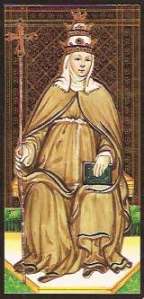History
 The story of Tarot’s evolution takes us from the aristocratic courts of medieval Italy to 21st century digital galleries; with stops along the way at French print shops, English occult lodges, and California communes. On these pages I’ve distilled the best tarot scholarship of the past few decades into an illustrated narrative of Tarot’s invention, development as a card game, and evolution into a contemporary tool for psychological insight and creative exploration.
The story of Tarot’s evolution takes us from the aristocratic courts of medieval Italy to 21st century digital galleries; with stops along the way at French print shops, English occult lodges, and California communes. On these pages I’ve distilled the best tarot scholarship of the past few decades into an illustrated narrative of Tarot’s invention, development as a card game, and evolution into a contemporary tool for psychological insight and creative exploration.
Fasten your seatbelts and get ready for a fast-paced ride through 600 years of tarot history.
DISCLAIMER
There’s no such thing as complete objectivity — every historian sees the world through a cultural lens. From my North American perspective, Tarot bubbled up from the collective medieval consciousness in northern Italy, flowed through France and jumped the English Channel. Then, like so many immigrants, it crossed the Atlantic to the United States in the early 20th century, where American freedom and ingenuity promoted a creative explosion that’s still travelling the globe. If I lived in another part of the world this story would have a different slant.
It’s my view that tarot was designed to tell a conventional Christian story using images from late Medieval popular culture. Associating tarot with Cabala, the grail legend, alchemy, or other divination systems is an artificial overlay. Tarot was not invented with any of these systems in mind, but these associations work well in the realm of the imagination and can add depth to one’s understanding of the cards.

